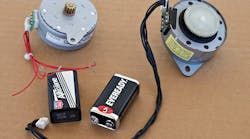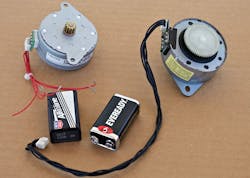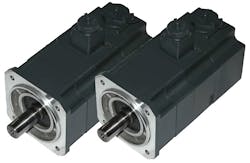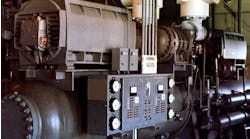Comparing the Basic Design of Stepper and Servo Motors
Stepper motors resemble servo motors in that both types are characterized by an ability to rotate a partial turn and then stop for any interval with or without holding torque. In addition, both motor types are externally commutated. However, the difference is the stepper motor operates in an open loop control system while the servo motor works in a closed loop system.
Stepper motor basics
Also correctly called the step or stepping motor, this type of motor is similar to a brushless DC motor in that it is externally commutated. Although this type of motor is simple in design and inexpensive, it does suffer from one disadvantage. If the motor falls out of sync for any reason, it must be stopped so it can go back and start from zero. A controller that is located outside of the motor provides electrical pulses to the field windings so that the armature can pursue the rotating magnetic field created by the field windings. For any electrical motor to turn, energy has to be fed to either the rotating armature, to the stationary field windings, or (as in a universal motor) to both.
The step motor does as commanded by the controller unless, due to load binding, electrical fault, or other misadventure, synchronization is lost. If, after the last command sequence, the load is at 45 degrees rather than 0 degrees, for example, and if the controller tells the motor to do a 90-degree step, the load will be at 135 degrees rather than 90 degrees. For subsequent steps, the error will be perpetuated. Damage can range from trivial to catastrophic. The solution following this unfortunate event is to halt the operation and synchronize controller and step motor.
The most basic type of stepper is the variable reluctance motor. Featuring a soft iron structure attached to the outside of the armature, this piece is comprised of notched teeth that rotate with the armature very close to the stationary field windings — separated from them by a small air gap. For a variable reluctance step motor to rotate, the notched teeth are critical because these alternating segments are successively closer and farther away from the stationary field windings. Armature rotation takes place because of the basic physics principle that a free-moving body of high magnetic permeability — notably soft iron — will move in such a way as to acquire a magnetic flux path with the least reluctance. (Reluctance in a magnetic circuit is equivalent to resistance in an electrical circuit. Magnetic flux always involves a circuit, although sometimes, as in the case of a stationary permanent magnet, this circuit is open.)
Because soft iron is more permeable to magnetic flux (comparable to current in an electrical circuit), there is less reluctance when the protruding portion of the notched ring passes through the flux lines emanating from the stator. Conforming to the physical principle stated above, the armature will always strive to position itself for minimum reluctance in the magnetic circuit.
For step motor rotation to occur, the magnetic field has to turn. To make this happen, the field coils must be energized at levels that vary periodically. Accordingly, an external controller is required to generate pulses that are fed to each field coil through appropriate wiring. If there are three field coils, theoretically there would be six wires. In actual practice, however, one side of each coil is connected inside the motor to a common wire so there are five wires going back to the controller.
The NEC does not require very small motors to have nameplates. Step motors can be distinguished from small DC motors by the presence of many wires as opposed to a 2-wire design. There is not a consistent color code, but the common wire can be identified by “ringing out” the motor with an ohmmeter. You can also manually pulse a step motor using a 9V battery.
What makes a step motor useful is the fact that a single pulse will make the motor turn a part turn, then remain stationary with or without holding torque produced by static DC from the controller. This does not overheat the motor due to sufficient impedance in the windings.
Multiple varying numbers of turns and incremental part rotations in rapid succession may be accomplished by means of controller programming. We have all seen this activity in inkjet printers, and it is widely used in student robotics projects. For continuous rotation, a waveform from the controller is capable of causing the step motor to turn at any desired speed(s), reversing and making fractional turns as required by the application.
Step motors are manufactured with differing numbers of notched teeth and field coils. Their numbers determine the smallest possible step or partial turn, usually expressed in degrees. A 1.8-degree stepper has a maximum of 200 possible steps in a single rotation of the armature.
Besides the variable reluctance model, there are three other types of step motors:
• Permanent magnet stepper
• Hybrid synchronous stepper
• Lavet stepper
In place of notched teeth, permanent magnet step motors have rotors consisting of permanent magnets. These motors have greater dynamic and holding torque compared to the variable reluctance motor.
Hybrid steppers combine variable reluctance and permanent magnet technologies to offer greater power in a smaller motor.
The Lavet-type stepping motor (invented and patented by French engineer Marius Lavet in 1936) is only able to turn in one direction because it is single-phase. Quartz clocks contain this type of motor. It is perfect for wrist watches because the motor requires very little power so that a small battery lasts for many years. Another application is automotive dashboard instrumentation.
Servo motor basics
Servomotors comprise a portion of the world-wide multi-billion dollar electrical motion control infrastructure market. At the small end of the scale, servo motors are usually brushed permanent magnet DC motors. Electronically commutated brushless DC motors are used in small industrial applications. The servo motor prevails where reliability and robust performance are needed — and where cost is not the decisive issue.
The servo motor is not prone to this difficulty because it incorporates a system known as closed-loop control. (The step motor-controller system is open loop.) A necessary component for the servo motor’s closed-loop operation is a sensor, if possible located at the load rather than at the motor, in case the fault occurs between the two.
Servomotor control is made possible by sensing the position and/or speed of the motor or load. This information is relayed back to the controller. If an error (discrepancy between actual and desired load behavior) is detected, the controller sends appropriate command data to the motor so that things get back on track. This is a continuous, ongoing process.
A number of algorithms are possible, but by far the most common is proportional integral derivative (PID). This generic protocol, widely used in many electrical and non-electrical applications, is appropriate for servo motor control.
It emerged in the 1890s when engineers, working to design an automatic steering mechanism for ships at sea, carefully recorded the motions of an expert helmsman at the wheel of a ship during turbulent conditions. It was found that the helmsman’s rapid motions conformed to certain patterns which, when analyzed, became known as PID.
PID is a form of three-term control. You unconsciously indulge in this algorithm when driving a car through busy traffic. Steering, acceleration, and braking respond to signals processed in the brain, which then calculates optimum actions based on proportional, integral, and derivative values. The control loops of most servo motors use the PID algorithm. The proportional (P) component is snapshot of present error. Integral (I) is the accumulation of past errors. Derivative (D) is a projection into the future, where the error is estimated as a function of the rate of change. These quantities are weighted in accordance with the nature of the task, and a continuously revised signal is generated, modifying the electrical energy supplied to the motor.
Most servo motors are characterized by precise angular positioning as opposed to ongoing rotation. The term servo motor does not denote a particular type of motor, but rather the motor-sensor-controller combination. The defining characteristic is that the control is closed-loop. A standard servo motor is capable of rotating 120° to 180°. A continuous servo motor can rotate as much as 360° in either direction. Both are imminently suitable for robotic assembly line production. It is not uncommon for a single unit to incorporate two or more motors. Other uses include solar array tracking and the clock drive for an astronomical telescope so that it can remain pointed at celestial objects for long hours to facilitate time-exposure photographs. Connected via USB to a laptop, these instruments can instantly find any of thousands of deep-sky objects that are invisible to the naked eye.
Pulse width modulation (PWM) is an algorithm that permits the controller to vary a servo motor’s position without large power losses. The standard electrical configuration is three wires from the controller to the motor. The color code is not entirely consistent. Typically, it’s red for power, black for ground, and white to convey the pulse width-modulated signal to the motor.
PWM permits an analog circuit to be controlled by a digitally generated signal. The waveform conveyed from the controller to the motor is a square wave. Varying amounts of current flowing through this circuit can be regulated not by the conventional method of altering the voltage, but by an interesting scheme of changing the proportion of ON and OFF time within each square-wave cycle.
Solid-state circuitry within the motor enclosure interprets the duty cycle of this signal and causes the motor armature to turn precise amounts in order to perform welding, drilling, painting, or other tasks in the required sequence.
The frequency of the PWM signal is not relevant. It just has to be within limits spelled out in the servo motor manufacturer’s documentation. What controls the motor’s position is the width of the ON (high logic) pulse. This is measured in thousandths of a second, or milliseconds (msec). For a standard or continuous servo motor, a 0.7 msec to 1.0 msec high pulse produces a clockwise (facing the shaft) step. A standard or continuous servo motor executes a counter-clockwise step when fed a 1.7 msec to 2.0 msec high pulse. A standard servo motor moves to the center position when it sees a 1.5 msec high pulse. Note that these pulses are in the control circuit, not the power circuit.
These are the basic principles that underlie stepper and servo motor operation. Designing and installing systems requires a little digital sophistication, especially in tweaking the servo motor feedback loop, but once in place the equipment is very stable and simple to troubleshoot and maintain.
Herres is a licensed master electrician in Clarksville, N.H. He can be reached at [email protected].





